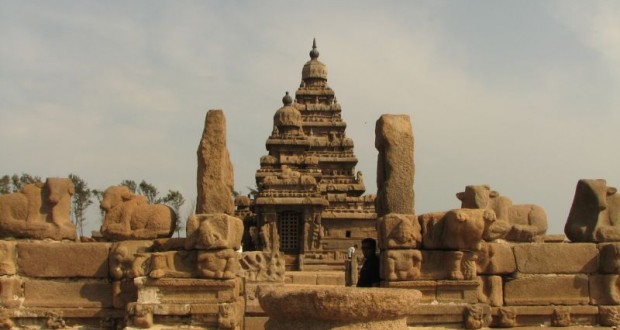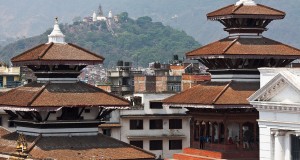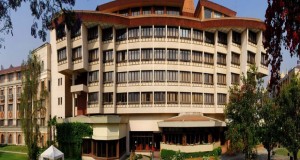Shore Temple-Krishna Mandapam-Descent of the Ganga-Cave Complex-Five Rathas
Time and especially tide has washed away all but one of Mahabalipuram’s seven famous seashore
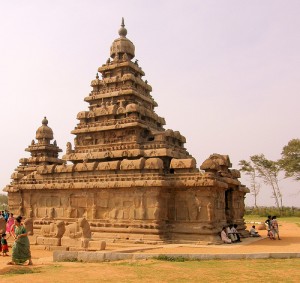 temples. To see the single surviving example, take a 5-minute stroll down Beach Rd (left out of the bus-stand). Though built in the final phase of Pallava art by Rajasimha (700-28), the Shore Temple is the first thing most people head for. This, one suspects, is partly because nobody expects it to last much longer. It sits perched on the very edge of the angry sea, constantly battered by the pounding surf, and is almost certainly doomed. All of this, of course, only adds to its romantic charm.A simple, elegant structure with layered pagoda roof, this shore temple is one of the oldest temples in South India. It’s unusual in that it houses shrines for both Vishnu and Shiva. The Shiva temple faces east and opens out on the sea, allowing the first rays of the sun to enter the shrine each morning to pay homage to the god. The smaller shrine faces west. Between the two shrines is the Vishnu temple, without a shikhara tower. This is the oldest part of the temple.
temples. To see the single surviving example, take a 5-minute stroll down Beach Rd (left out of the bus-stand). Though built in the final phase of Pallava art by Rajasimha (700-28), the Shore Temple is the first thing most people head for. This, one suspects, is partly because nobody expects it to last much longer. It sits perched on the very edge of the angry sea, constantly battered by the pounding surf, and is almost certainly doomed. All of this, of course, only adds to its romantic charm.A simple, elegant structure with layered pagoda roof, this shore temple is one of the oldest temples in South India. It’s unusual in that it houses shrines for both Vishnu and Shiva. The Shiva temple faces east and opens out on the sea, allowing the first rays of the sun to enter the shrine each morning to pay homage to the god. The smaller shrine faces west. Between the two shrines is the Vishnu temple, without a shikhara tower. This is the oldest part of the temple.
For a proper appreciation of this spectacular monument, hire a guide at the entrance—they speak good English, and treat their subject with warmth. Entering the temple enclosure, note the series of guardian bulls (Nandis) on the surrounding walls. Then, within the frontal shrine the bas-relief of Shiva, attended by Parvati (his wife), Brahma (as wisdom) and Vishnu (as eagle-god). Parvati’s good-fortune son, Ganesh, is present, but not his brother Muruga (god of beauty and war). Left, in the second chamber (there’s one on each side of the temple), you’ll find the 2.5-m • monolith of Vishnu in the attitude of repose. The rear chamber has the ancient, much-prized linger , just a part of which now remains. Facing the lingam is the carving of a cow, representing a permanent sacrifice to the presiding deity. In the last chamber, you’ll see the female symbol, a circular recess in the floor.
Walk down the beach to get the full effect of the shore temple; it is best viewed from a 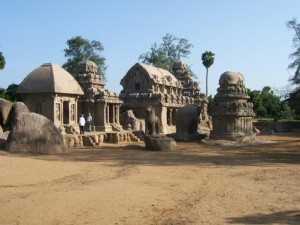 distance, and in the subdued light of late afternoon. If going in for a swim, be careful—the waves are invigorating but the current very strong. Drying off, be prepared to entertain the ‘lobster-man’, the ‘coconut man’ and a procession of hopeful youngsters hawking seashells and stone-carved images. The coconuts are refreshing. To get some peace, stroll down the beach, either side of the temple, until you find a quiet stretch of sand.
distance, and in the subdued light of late afternoon. If going in for a swim, be careful—the waves are invigorating but the current very strong. Drying off, be prepared to entertain the ‘lobster-man’, the ‘coconut man’ and a procession of hopeful youngsters hawking seashells and stone-carved images. The coconuts are refreshing. To get some peace, stroll down the beach, either side of the temple, until you find a quiet stretch of sand.
Back at the top of Beach Rd, bear left for Krishna Mandapam. Mahabalipuram has eight such mandapams (rock-cut cave temples), each one an exquisite study in bas-relief portraying various vivid episodes from Hindu legend or mythology. This one depicts Krishna using the umbrella of Mount Govardhan to shield his flocks of cows and shepherds from the rage of the rain god, Indra. It is noted for its realistic representation.
Nearby is the world’s largest stone bas-relief, The Descent of the Ganga. This amazing piece of sculpture represents the earliest work of the Pallava sculptor, undertaken during the reign of Narasimhavarman I after whom the town is also named (this king earned the title of Mammals or ‘The Great Wrestler’). The Penance itself is a massive whale-back shaped rock, split down the middle with a fissure, the whole face of which is covered with relief sculptures. Measuring 27 m long, 9 m high, this vast stone frieze faces out to the sea. It pictures over a thousand sculpted deities and animals, each one a work of art. Dominated by a procession of elephants, two of which are 5 m, it portrays a dynamic world of gods, demi-gods, angels, men, animals and birds, all apparently rushing towards the cleft in the rock’s centre.
It is said either to represent the Mahabharata fable in which Arjuna, the emaciated figure seen standing on one leg, did penance to Shiva after fighting alongside Krishna and killing many fellow human-beings; or the ‘descent of the Ganga’ from Mount Kailash, the holy river seen flowing down from Shiva’s matted locks. In this story Bhagiratha, a mythical hero, 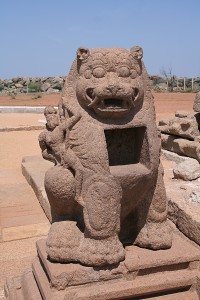 beseeched the gods to send down the celestial waters of the Ganga (the Ganges), to carry the ashes of his ancestors to nirvana. But he unleashed a mighty flood, only contained when Shiva mopped up the waters with his hair. Whatever the sculpture means, it’s a masterpiece.
beseeched the gods to send down the celestial waters of the Ganga (the Ganges), to carry the ashes of his ancestors to nirvana. But he unleashed a mighty flood, only contained when Shiva mopped up the waters with his hair. Whatever the sculpture means, it’s a masterpiece.
A huge granite hillock overlooks the Descent of the Conga. The path up there leads past a number of interesting rock-cut caves, and peters out near Krishna’s Butter Ball, an immense boulder which is delicately poised on the crest of the hill. Like the Shore Temple, you can’t imagine it staying there much longer. Behind it, pause for the beautiful view over Koneri Lake, a pretty inland lagoon with one of the ancient rathas situated on the far bank. Then proceed, via the colonnaded Sthalasayana Perumal Temple, to the high Lighthouse. You can climb to the top provided you arrive before noon, for a glorious view over the town and surrounds. Officially, no photos are allowed from the top. Below the lighthouse is the Mahishasuramardhini Cave, with a famous frieze of Durga (Kali) destroying the buffalo-headed demon Mahishasura. In the background, oblivious to all this activity, there’s Vishnu in one of his famous ‘cosmic sleeps’.
From the hillock, it’s a 15-minute (1.6-km; 1-mile) walk down to the enclosure of the Five Rathas. These five monolithic ‘temple cars’ (four named after the Pancha Pandava hero brothers of the Mahabharata epic, the fifth after their wife, Draupadi) are the 7th-century prototypes of all Dravidian temples to come. Five differing monolith miniature temples, they display the familiar gopurams (gatehouse towers), and vimanas (central shrines), mandapams (multi-pillared halls) and sculptured walls so characteristic of later temple architecture. The rathas themselves are simple, unadorned structures, each of a different style, but all are viharas or monastery buildings. They are either square or oblong in plan, and pyramidal in elevation. Adorned with rampant lions, elegant pillars and sculpted divinities, they stand (unfinished) in lonely, isolated splendour, guarded by three life-size stone animals: a lion facing north, a central giant elephant looking south, and a bull to the east.
End your tour with a visit to the pleasant open-air Museum in town, and be sure to return to the Shore Temple on a moonlit night.
Tirukkalikundram (by bus, taxi or motorbike, half-day)
This semi-interesting little Shiva temple, situated atop Vedagiri Hill,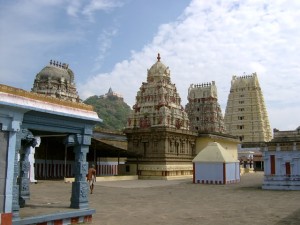 is located 16 km (10 miles) out of Mahabalipuram. It’s covered on the 1-day tour to Mahabalipuram sold by TTDC in Madras, but is a worthwhile little excursion from Mahabalipuram itself.
is located 16 km (10 miles) out of Mahabalipuram. It’s covered on the 1-day tour to Mahabalipuram sold by TTDC in Madras, but is a worthwhile little excursion from Mahabalipuram itself.
Tirukkalikundram has a famous popular eagle sanctuary at the temple, where two white eagles (apparently the reincarnations of two famous saints) fly in around noon daily, ostensibly for a rest on their flight between Varanasi and Rameshwaram, but in fact to grab a free lunch issued by the temple priest. Before you make the wearisome climb up 565 steps to the hilltop sanctuary (in bare feet) check that the birds have actually made it. Other attractions at Tirukkalikundram include a large tank, to the south-east of town, with alleged curative powers, and a marvellous temple complex at the base of the hill.
RECREATION
During the day, you can hire out four-log fishing boats down by the Shore Temple. For around Rs50 per head, fishermen will take you about 3 km (1 3/4 miles) out to sea—and then demand another Rs30 to take you home again. In the evening, pop along to Silver Sands hotel classical dance performances and music concerts that are held here nightly from 9.30 pm onwards. The admission charge of about Rs40 is steep, but it’s the only show in town.
SHOPPING
Mahabalipuram doesn’t have much to offer. Real leather shoes often turn out to be real plastic, and cost twice as much as in Madras. The town’s stone masons, drawing on the skill of centuries, produce some decent Indian images in marble and a lot of tourist tat in alabaster (which scratches, by the way). If you’re going to do any shopping at all, save your money for Poompuhar Government Emporium on Shore Temple Rd. This has an interesting assortment of ceramics, handicrafts, perfumes, cut glass and dolls at more or less fixed prices. It’s closed on Tuesday.

